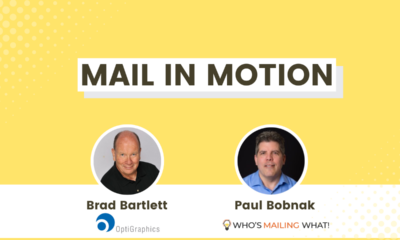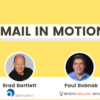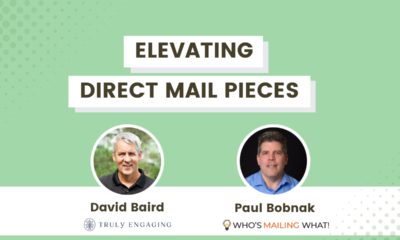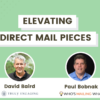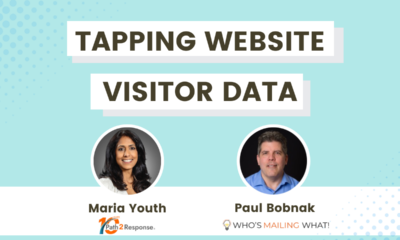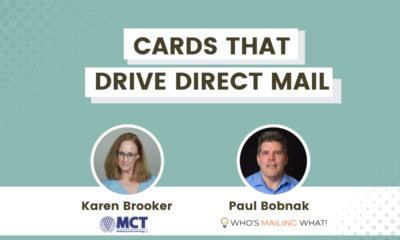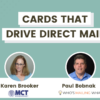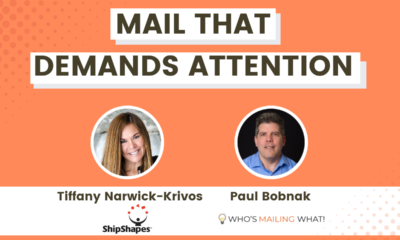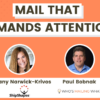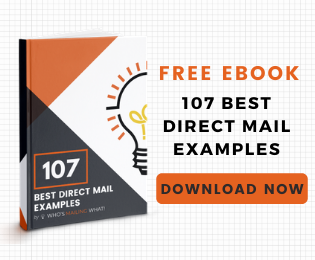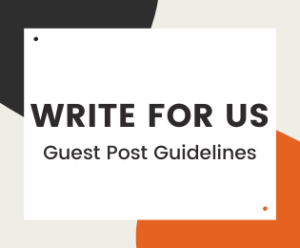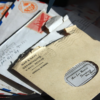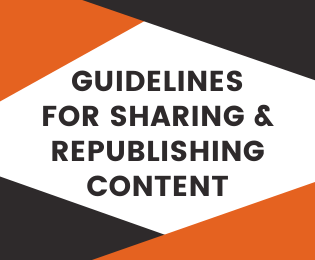MEET THE MAILERS
Meet the Mailers: Reinventing Print and Mail
In this episode, we talked with Hudson Printing about how the company is focused on reinventing print to provide value to customers.
In this episode, I talked with Paul Hudson, Owner & CEO of Hudson Printing. Based in Salt Lake City, UT, Hudson Printing is recognized for innovation in print production, web-to-print solutions, data-driven print fulfillment, and ecommerce.
Much of our discussion focused on two important and related topics: the company’s commitment to “reinventing” print and its introduction of carbon balanced sustainable mail.
Showing a sample produced on carbon balanced paper, Hudson noted that:
“The Landa press prints so beautifully on uncoated paper … so it’s sustainable, fast and beautiful. And we can make it affordable.”
 Paul Hudson
Paul Hudson
Owner/CEO
Hudson Printing
Among the many topics we covered:
- Paul’s background
- Hudson Printing’s mail and print products and services
- What reinventing print means
- How print interacts with data and the digital world
- Trends in direct mail
Here are some questions and answers from our conversation (edited for clarity and space):
- Can you give a brief rundown of your services, printing, mailing, etc.?
So we’re in Salt Lake City, which is a great location to service the western half of the US and we certainly do national things as well, particularly as it involves mail but for most of our existence, we’ve been kind of in the Intermountain region and we have easy and really nice freight lanes into the coast. It’s a 2-day service essentially throughout the entire half of the country. It’s a nice place to be and we’ve really grown up in recent times as a web offset printer. [I]t’s magazines and catalogs and mailing a lot of flats and that kind of thing and marketing pieces of all types are really commercial printers. And then over the last decade or so … we’ve really focused on also building a very dynamic digital print business that is complementary to our traditional business. We still operate and run our web offset traditional business, but are also focused very heavily on lots of the new tricks.
- [A]bout the slogan I saw on your website … “reinvent print” …what does that mean in general, what about print needs to be reinvented?
Well, thank you for asking. I love that question because honestly, “reinvent print”, it almost sounds like we’re kind of in the background with our chemistry degrees working on new ink or new blankets or new technologies to put ink on paper. And it really isn’t that at all. Obviously. In my mind, what that really means is how do we reinvent the value of print for our customers? How do we make what we’re sending, what we’re producing for our customers, work better?
I have a brilliant marketing friend who in the past talked to me about an old case study that McDonald’s had commissioned … McDonald’s was wondering why their customers buy milkshakes in the morning and so they went and did a Harvard marketing review of that. And what they found is that the people were actually hiring that milkshake to do a job for their lives. And my marketing friend said, “hey, you know what, the same thing is happening. Somebody’s buying that print in order to achieve a result. They’re buying that print to go out and do a job in the world.” And so ever since then, I’ve kind of called it my milkshake exercise as I tried to understand why it was that somebody bought that piece of print. What were they wanting it to do in the world?
And our job then is to how to make that work better, what tricks or tools or new equipment or ideas can I bring that helps it do better? I’m often telling my people here like you’re not in the business of producing print. You’re in the business of selling cars and filling theater seats and helping people have a place to journal their thoughts and all those kinds of things. So anything that we can do that helps our customers achieve that goal better – that’s reinventing print.
Print has all kinds of new and fun technologies and tools in order to do that. And I find that most of our customers don’t understand it. They don’t know that. They don’t understand the power of personalization. They don’t necessarily know what new embellishment capabilities exist or what expanded gamut printing might look like or whatever. We have so many opportunities and tools and cool things that we can do. It’s our job to reinvent print products for our customers by helping take those tools to them to the end of making the purpose for which they bought that piece of print work even better than they might have thought of on their own.
It can be hard to do but what we seek to be is the leaders of valuable print, right? And that might mean that there’s a little less print. If we can produce a better result for our customers, even if there’s a little bit less print, well, that’s fine by us. What we want to be is the leaders in valuable print, the leaders in print that actually achieves the… particular result that they’re seeking better than any other method.
- You’ve talked about the Landa press that you’ve brought into the company and how it makes long runs easier and they’re more impactful. I’ve always loved talking about data and using data better, making it more impactful and how that really should be guiding a lot more about what’s going on in direct mail. How does that work with VDP in driving that value?
So when we started this digital print journey back in 2012 I developed a really simple Venn diagram which … has been guiding the principle or been guiding our investment decisions. We’re more than a decade now and essentially, the first circle is just print. So we’re printers, that’s our craft. Anything we can do that makes something beautiful with better textures, better delivery, more emotional, then that’s what we should be doing, right? That’s where we should focus.
Second is where does data go. Any place where those two circles of data and print intersect makes it more valuable. So we should absolutely be integrating that in many different ways. And whether that’s full personalization or just regionalization or …making it easier to do versioning for the marketers that we’re serving.
And then just to finish the thought, the third circle is actually digital. Not digital print but the digital world. So maybe a place where our print is interacting with the digital world. The most obvious and easy example of that being a QR code.
Fantastic, right? So any place where print and digital interact that increases the value, any place where print and data interact increases the value, any places where all three circles interact – that’s what we want to do. And in my mind, that is what “reinvent print” is, going back to your prior question. Anywhere that we can create that more valuable print, which in my mind is the intersection of those three things, that’s what we want to be about.
- I also want to bring into the discussion “Sustainable Mail”. What’s the story behind it? What is it to begin with?
Because you had asked about Landa, I’m gonna start with that because of the way that this interacts or the way this story started about sustainable mail and sustainablemail.com, so anybody can go and look at that. We’ve just recently launched it. It’s taken us a little while to get it up and going.
Sustainability is very important personally. And so I’ve been working with influencing what I can inside the business and my personal life to kind of align with those values. And so we were asked to produce a piece some months ago, for a paper mill in Canada that was doing some incredible work in sustainability. And they were producing 100% recycled uncoated paper that printed beautifully.
And so we produced this. Actually, I grabbed and have that piece here. It explains how the paper mill, their energy is 93% biogas which is captured methane from the local landfill and this brochure kind of tells the story of that. I said, “You’ve got to let me produce this piece on the Landa press” and because one, the Landa produces incredibly beautiful work on uncoated paper. But it also has quite a nice environmental story because the inks, not only are they water based and use no harmful chemicals, but they’re also very friendly in the recycling stream and because of nanotechnology, the ink is very, very thin. So there’s a very small amount of Me and so combining those two things with the fact that we actually buy that paper as carbon neutral and we actually have become a Carbon Balanced Printer ourselves.
[T]hrough the World Land Trust, we’re the first in North America to do that where we fully balance all of our emissions. [W]e produced this piece and out of that it just occurred to me “This is amazing. This paper is 100% recycled. It’s FSC-compatible. It’s all the … different logos and characters …plus the ink story, the Landa story, and then the carbon balancing story.” And I thought “this is remarkable … maybe there’s an opportunity in the market to do something that is different that truly focuses on it.” And so that’s what sustainable mail is all about.And honestly, we’re trying to do a few things. One, I just explained a lot of the sustainability story to it, but two, we have really strong automation technology, so we can produce mail very fast. Three, I already explained the way the Landa press prints so beautifully on uncoated paper … so it’s sustainable, fast and beautiful. And …we can make it affordable. I don’t like environmental things that are very boutiquey and it’s three times the cost or something. So our goal is to be able to do the most sustainable solution for printing direct mail. And from the sourcing and ink type and the carbon balancing, and then get it, make it beautiful and put it in the mail in a hurry and and don’t charge so much more. Don’t make it so expensive. That’s our goal with sustainable mail.
I think it’s a pretty compelling story. I think it also provides an alternative for people. So most of the time, if you go to an online mailing site or place where you can get some postcards in the mail or something, you might have an option to do 10% or even 30% recycled paper or something. But that’s usually kind of where it ends and our goal here was “no, this is the product we sell”. Like, you can’t buy our product non-carbon balanced …we will probably add some additional paper types. We started with this one that has this lovely story…we’ll probably add some others but you won’t be able to buy a non-100% recycled paper, for example in this case very likely.
- Thinking about other mail owners, printers, brands, what do you think that they can be doing proactively to bring or strengthen a sustainable or carbon-neutral print ecosystem and make that more of a reality?
We all have to, and I think that it starts with just recognition. [W]e work in a resource-intensive industry and it doesn’t do any of us any favors, our customers, ourselves, or the marketing people we’re working for if we don’t acknowledge that.
So I think the first thing we do is yes, we acknowledge that it is a resource-intensive industry and then we make good choices after that. We look for FSC- or PEFC- or SFI- certified paper. We work on our own waste profiles. We consider our carbon footprint. All of those things we can do and we have to do it as an industry, it can’t be just one or two of us. We all have to be working on it. And honestly, in North America we’re behind what I’ve seen and what I’ve witnessed in Europe and I think that printing companies who aren’t taking it seriously in Europe are losing business. I think that’s the way of the future for us as well. It will be part of it and and and it’s because brands are looking for solutions, brands have carbon targets that they’re trying to achieve. So we can help with that.
It’s becoming more and more important because it’s important for consumers of those brands. So then the brands, of course, put pressure on the manufacturers and their partners. But I think we shouldn’t wait to be forced. [W]e should be starting by understanding that lower waste is better, right? Lower smarter choices around sustainable things that are just good for all of us.
- Besides sustainability, what kinds of trends or thoughts do you have about the world of direct mail?
Well, what I believe is and I sort of already hit on this when we were talking about reinvent print and particularly just about valuable print generally, right … We have to prove our value. Print works. Print works and it’s a great fit for the modern marketer. It’s an absolutely critical part of the toolbox, but we have to make it easy, right? I think it’s still too hard to order print, so I think we need to work on that. I think that we often have better tools for integrating with our customers now and I think we need to do more and more of that, you know, whether it’s helping them kind of design campaigns… it’s sort of incumbent on us to help them understand, one, why and how it works and, two, how do we add the things that our print can do now? So many marketers really don’t understand that, you know all the things you can do in digital marketing, you can do in print, right? But we have to be smart about it. We have to integrate those elements. We have to work from data, from the point of data. And that’s what makes print valuable. So in my mind, because you asked kind of about the future, how do I kind of see the future? And for one, it’s that we have to understand data. We have to utilize data. So again that’s part of one of the circles in the Venn diagram.
The other piece of it is that we have to prove value, so attribution becomes very important and our methods are getting better, but they’re still not as good as they need to be and not as good at reporting all that as we should be. We have to prove ourselves to our customers. And then the third piece is again, it’s just back to that Venn diagram is what can we do to make print even more attractive?
And again, you know you’ve talked about Landa. I mean our Landa presses are 7-color, right? We’re actually doing some very interesting things with the newest version of Indigo as well, which we’re quite excited about. So print technologies that make print more beautiful, more stable, more you know quickly produced – all those things exist. We also have introduced embellishment and with the Scodix technology, introduced a product that we call TOPO that adds textures and contours and cool things to print. And most people don’t think, at least initially when we were considering how, how does that apply in our world? And it’s kind of easy to understand book covers because we, you know, we produce some books, maybe a special edition of a magazine cover, you know, hey, this is our 30th anniversary. Well, that maybe wants a nice touch to it. A nice special element to it. Those things are easy to understand, and we’re seeing success in that.
But most people think mail is too price-conscious, right? Nobody’d be willing to spend a little extra to create a little bit more dynamic element on a piece of direct mail. [But] we’re finding that’s not true. We’re finding a lot of interest among our direct mailers. They do kind of want to understand, “OK, this is going to cost me more. Will there be more benefit?” And the whole industry needs more data. We’ve actually been working with the FSEA, Foil and Specialty Effects Association to do some testing and I will tell you that kind of early results from one of the tests we did, the embellished versus non-embellished did add lift … about 4%. [A]gain you need more data, you need more science behind that. [S]o we have been doing quite a bit of testing with some of our direct mail clients for embellishments.
That’s all kind of in that circle of how do we make more print more attractive, more beautiful, more textured, more emotional, right? And so we believe in that too, so that it’s got to be more personal, it’s got to be more beautiful. It’s got to be more sustainable and we’ve got to do it fast. That’s the future. I think that’s how we succeed in the future.
Here is our conversation (with all questions and answers). We’ve added timecodes for your convenience.
Thank you very much, Paul, for sharing your perspective and your expertise! To learn more about Hudson Printing, visit their website at HudsonPrinting.com.
Your comments and ideas are very important to us in making your Who’s Mailing What! experience even better for you. Through these engaging talks, we hope you’ll take away practical tips, insights, and personal stories to inspire and build your own success.
If you have any feedback — or are interested in sharing your story and viewpoint with our wide and diverse audience on “Meet the Mailers” — please reach out to me. I’d love to hear from you!







